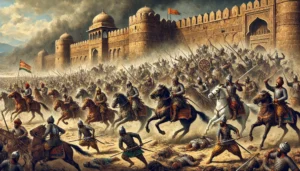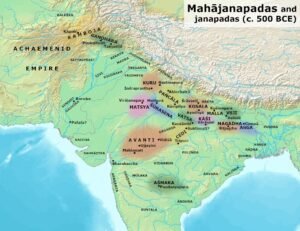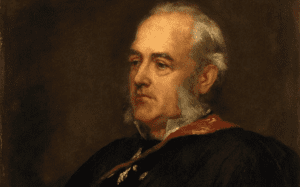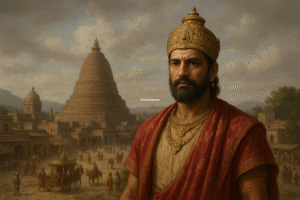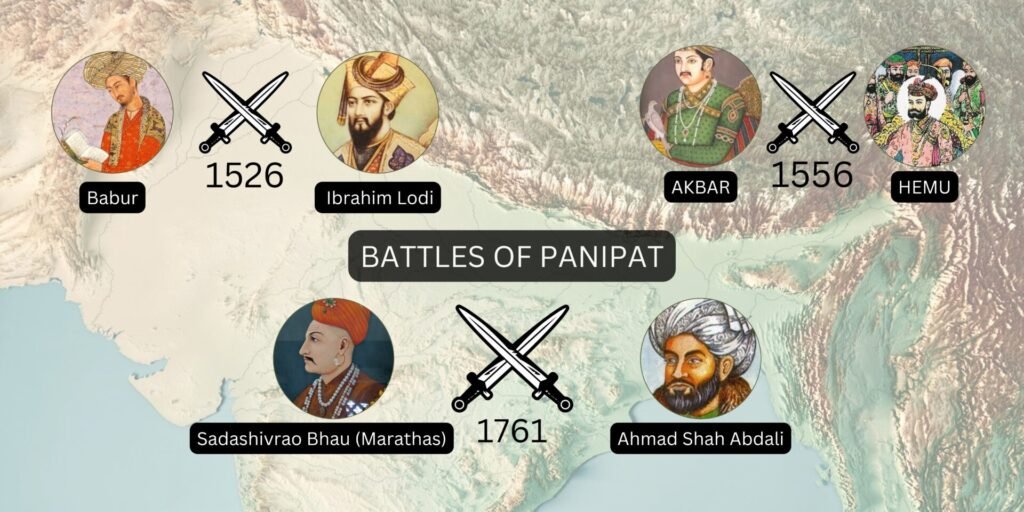
Panipat’s Deadly Legacy
The three Battles of Panipat (1526, 1556, and 1761) are among the most important military engagements in Indian history. They were fought over a span of 235 years and shaped the subcontinent’s political trajectory, each time marking the rise or fall of empires and power structures that dominated North India. These battles not only changed the course of Indian history but also introduced new military technologies and strategies that would influence warfare in the region for centuries. This discussion delves deeper into the causes, key strategies, and reasons for victory or defeat in each battle, showing how they each became pivotal turning points in India’s history.
1. First Battle of Panipat (1526): Babur vs. Ibrahim Lodi
- Background: The first Battle of Panipat was the culmination of Babur’s invasion of India. Babur, a descendant of Timur and Genghis Khan, sought to expand his rule into the fertile and wealthy lands of North India. The Delhi Sultanate, ruled by Ibrahim Lodi, was weakened by internal dissent, making it vulnerable. Babur, armed with advanced artillery, sought to challenge Lodi for control of Delhi.
- Why It Took Place: Ibrahim Lodi’s autocratic rule alienated many regional chiefs and nobles, who sought Babur’s intervention to overthrow him. Babur, after several unsuccessful invasions, finally mobilized a well-organized and disciplined army equipped with gunpowder, artillery, and matchlock muskets, marking a departure from traditional Indian warfare.
- Key Strategies: Babur employed the Tulughma tactic, a highly organized military strategy where his troops were divided into smaller units to encircle and outflank the enemy. His use of cannons and gunpowder to disrupt Lodi’s massive but disorganized army proved decisive. This was the first time artillery was used effectively in Indian warfare.
- Reasons for Babur’s Victory: Babur’s superior military strategy, combined with his use of modern weaponry, overwhelmed the larger but poorly coordinated forces of Ibrahim Lodi. Ibrahim Lodi’s outdated methods of warfare and failure to unite his nobles contributed to his defeat.
- Turning Point in History: The end of the Delhi Sultanate and the establishment of the Mughal Empire marked a significant shift in the political landscape of North India. The Mughal Empire, with its sophisticated administrative and military systems, would dominate India for the next three centuries.
2. Second Battle of Panipat (1556): Akbar vs. Hemu
- Background: After the death of Emperor Humayun in 1556, the Mughal Empire was in disarray. Hemu, a Hindu general and chief minister of the Afghan ruler Adil Shah Suri, declared himself the ruler of Delhi after a series of military victories, including capturing Delhi and Agra. At this critical juncture, the 13-year-old Akbar, under the regency of Bairam Khan, prepared to reclaim his father’s legacy.
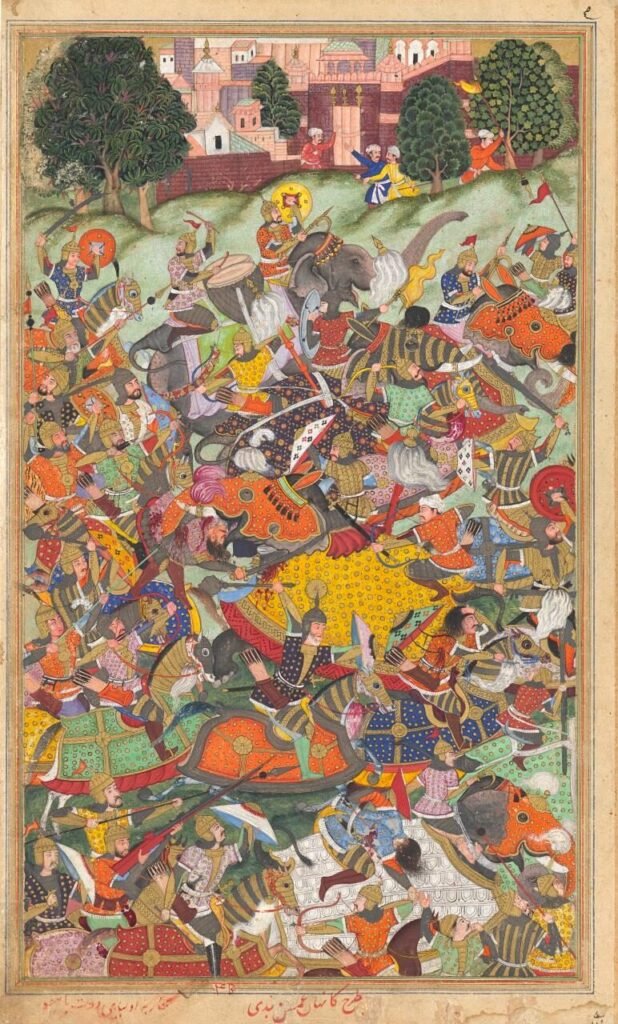
(c. 1595-1600)
- Why It Took Place: Hemu’s ambition to establish a Hindu kingdom by overthrowing the weakened Mughal forces, coupled with the political instability following Humayun’s death, made the second Battle of Panipat inevitable. Akbar and his regent Bairam Khan saw Hemu’s rise as a threat to Mughal authority and sought to defeat him to reestablish Mughal dominance.
- Key Strategies: Hemu relied heavily on his experience as a military commander and his use of elephants in battle. His forces outnumbered the Mughals and had successfully captured Delhi before the battle. Bairam Khan, leading Akbar’s army, strategically deployed his forces with careful use of mounted archers and light cavalry. The Mughal army maintained a disciplined formation, awaiting Hemu’s elephant charge before launching a counterattack.
- Reasons for Mughal Victory: The disorganization of Hemu’s army after he was wounded was a major factor in his defeat. The Mughals, under Bairam Khan’s leadership, maintained discipline and used tactical maneuvers effectively.
- Turning Point in History: This battle reaffirmed Mughal supremacy in North India, preventing the rise of a powerful Hindu kingdom under Hemu. Akbar’s subsequent reign (1556–1605) became a defining era in Indian history, marked by administrative reforms, cultural achievements, and religious tolerance.
3. Third Battle of Panipat (1761): Marathas vs. Ahmad Shah Abdali
- Background: By the mid-18th century, the Marathas had become the dominant power in India after the decline of the Mughal Empire. However, their growing influence in North India, including control of Delhi, threatened regional powers like Ahmad Shah Abdali (Durrani), who sought to reestablish his authority over Punjab and halt Maratha expansion.

- Why It Took Place: Ahmad Shah Abdali invaded India to reassert his control over Punjab and push back against the Marathas, who had taken control of Delhi in 1757. The Marathas, aiming to establish themselves as the dominant power in North India, mobilized their army to confront Abdali’s invasion. The two sides clashed at Panipat in what would be one of the largest and bloodiest battles of the 18th century.
- Key Strategies: Abdali’s forces used superior cavalry tactics and guerrilla-style ambushes, exploiting the Maratha army’s reliance on heavy infantry and limited supply lines. The Marathas, led by Sadashivrao Bhau, had a vast army but struggled to maintain long supply lines. They were cut off from their bases in Maharashtra, which left them vulnerable. Abdali also formed strategic alliances with local powers, including the Rohilla Afghans and Shuja-ud-Daula, to strengthen his position against the Marathas. The Marathas attempted a direct engagement without adequate logistical preparation, and their over-reliance on infantry and static defenses made them vulnerable to Abdali’s highly mobile cavalry forces.
- Reasons for Maratha Defeat: The Marathas were outmaneuvered by Abdali’s superior cavalry tactics, and their forces were left weakened by starvation and supply issues. Abdali’s strategic alliances with local powers and his ability to divide the Maratha coalition played a critical role in their defeat.
- Turning Point in History: The defeat marked the end of the Marathas’ dominance in North India, leaving the subcontinent fragmented and politically unstable. The battle created a power vacuum, allowing the British East India Company to gradually expand its influence in India, ultimately leading to British colonization.
Each of the Battles of Panipat served as a decisive turning point in Indian history. The first battle established the Mughal Empire, bringing a new era of centralized power and cultural fusion. The second battle secured Mughal dominance under Akbar, ensuring a long period of stability and prosperity. The third battle shattered Maratha hopes of ruling India and created the conditions for the rise of British colonial power. These battles not only altered the political fate of India but also introduced significant changes in military tactics and governance that would shape the subcontinent for centuries to come.

